Religion Roman Catholicism Area 111,900 km² Date dissolved 1861 | 1808–1815 Joachim I (first) 1860 est. 8,703,000 Founded 1816 | |
1860 111,900 km² (43,205 sq mi) Government | ||
The Kingdom of the Two Sicilies (Neapolitan: Regno d"e Ddoje Sicilie, Sicilian: Regnu dî Dui Sicili, Italian: Regno delle Due Sicilie) was the largest of the states of Italy before the Italian unification. It was formed as a union of the Kingdom of Sicily and the Kingdom of Naples, which collectively had long been called the "Two Sicilies" (Utraque Sicilia, literally "both Sicilies").
Contents
- Kingdom of the two sicilies reino de las dos sicilias 1816 1860
- Name
- Establishment of the Kingdom of the Two Sicilies
- Origins of the two kingdoms
- Aragonese and Spanish direct rule
- Crowns Unification
- Invasion by Piedmont
- Departments
- Industry
- Transport
- Technological and scientific achievements
- Kings of the Two Sicilies
- Titles of King of the Two Sicilies
- House of Bourbon in exile
- Heads of the Royal House of the Two Sicilies 1861present
- Calabria line
- Castro line
- Current lines of succession
- Orders of knighthood
- References
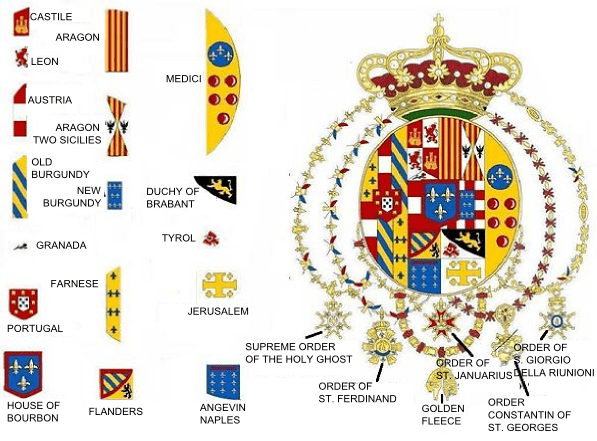
The Kingdom of the Two Sicilies lasted from 1815 until 1860, when it was annexed by the Kingdom of Sardinia to form the Kingdom of Italy in 1861. The capitals of the Two Sicilies were in Naples and in Palermo. The kingdom extended over the Mezzogiorno (the southern part of mainland Italy) and the island of Sicily. Jordan Lancaster notes that the integration of the Kingdom of the Two Sicilies into the Kingdom of Italy changed the status of Naples forever: "Abject poverty meant that, throughout Naples and Southern Italy, thousands decided to leave in search of a better future." Many went to the United States, Australia and Argentina. The kingdom was heavily agricultural, like the other Italian states; the church owned 50–65% of the land by 1750.
Kingdom of the two sicilies reino de las dos sicilias 1816 1860
Name
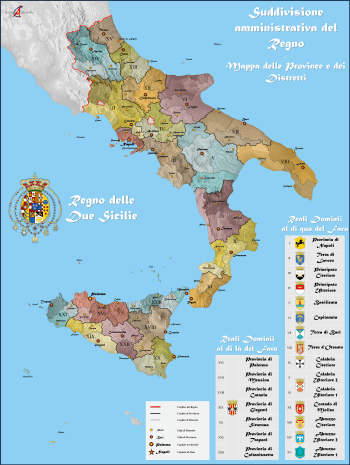
The name "Two Sicilies" originated from the division of the medieval Kingdom of Sicily. Until 1285, the island of Sicily and the Mezzogiorno each formed part of the Kingdom of Sicily. As a result of the War of the Sicilian Vespers (1282-1302), the King of Sicily lost the island of Sicily (also called Trinacria) to the Crown of Aragon, but remained ruler over the peninsular part of the realm. Although his territory became known as the Kingdom of Naples, he and his successors never gave up the title of "King of Sicily" and they officially referred to their realm as the "Kingdom of Sicily". At the same time, the Aragonese rulers of the island of Sicily called their realm the "Kingdom of Sicily" as well. Thus, formally, there were two kingdoms calling themselves "Sicily": hence, the Two Sicilies.
Establishment of the Kingdom of the Two Sicilies
The Kingdom of the Two Sicilies resulted from the re-unification of the Kingdom of Sicily with the Kingdom of Naples (called the Kingdom of Peninsular Sicily), by King Alfonso V of Aragon in 1442. The two states had functioned as separate realms since the War of the Sicilian Vespers in 1282. At the death of King Alfonso in 1458, the kingdom again became divided between his brother John II of Aragon, who kept the island of Sicily, and his illegitimate son Ferdinand, who became King of Naples.
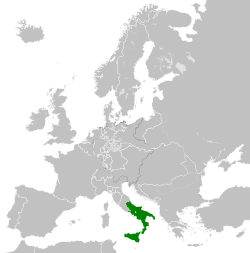
In 1501, King Ferdinand II of Aragon, son of John II, conquered Naples and reunified the two kingdoms under the authority of the newly united Spanish throne. The Kings of Spain then bore the title King of Both Sicilies or King of Sicily and of the Two Coasts of the Strait until the War of the Spanish Succession. At the end of that war, the Treaty of Utrecht in 1713 granted Sicily to the Duke of Savoy until the Treaty of Rastatt in 1714 left Naples to the Emperor Charles VI. In 1720 the Emperor and Savoy exchanged Sicily for Sardinia, thus reuniting Naples and Sicily.
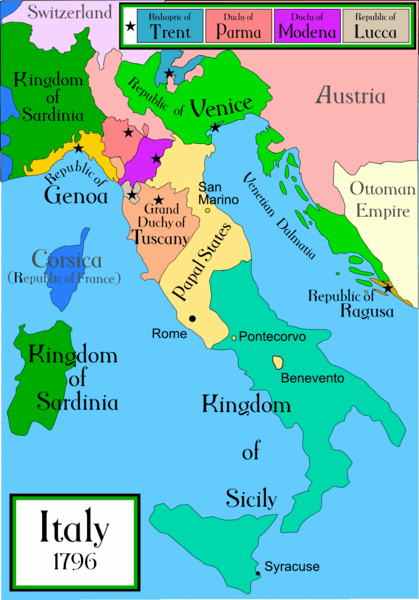
In 1734, Charles, Duke of Parma, son of Philip V of Spain, took the Sicilian crown from the Austrians and became Charles VII & V, giving Parma to his younger brother, Philip. In 1759, Charles became King Carlos III of Spain and resigned Sicily and Naples to his younger son, who became Ferdinand III of Sicily and Ferdinand IV of Naples, later crowned Ferdinand I of the Two Sicilies in 1816. Apart from an interruption under Napoleon, the Kingdom of the Two Sicilies remained under the Bourbon line (Bourbon Duo-Sicilie) continually until 1860.
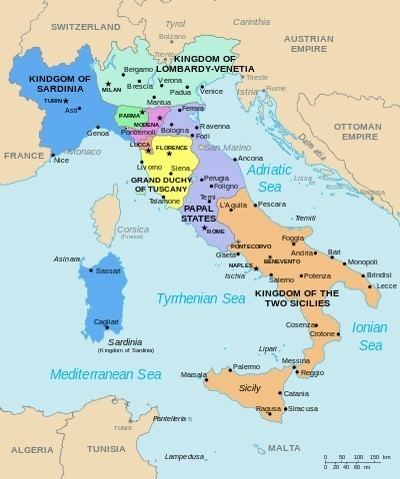
In January 1799, Napoleon Bonaparte, in the name of the French Republic, captured Naples and proclaimed the Parthenopaean Republic, a French client state, as successor to the kingdom. King Ferdinand fled from Naples to Sicily until June of that year. In 1806, Napoleon, by then French Emperor, again dethroned King Ferdinand and appointed his brother, Joseph Bonaparte, as King of Naples. In the Edict of Bayonne of 1808 Napoleon moved Joseph to Spain and appointed their brother-in-law, Joachim Murat, as King of the Two Sicilies, though this only meant control of the mainland portion of the kingdom. Throughout this Napoleonic interruption, King Ferdinand remained in Sicily, with Palermo as his capital.
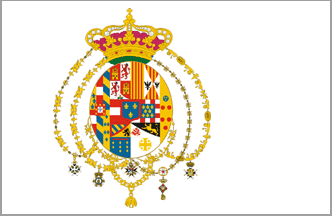
The Congress of Vienna restored King Ferdinand in 1815. He established a concordat with the Papal States, which previously had a claim to the land.
Several rebellions took place on the island of Sicily against King Ferdinand II (reigned 1830-1859), but the end of the kingdom came only with the Expedition of the Thousand in 1860, led by Garibaldi - an icon of Italian unification - with the support of the House of Savoy and their Kingdom of Piedmont-Sardinia. The expedition resulted in a striking series of defeats for the Sicilian armies facing the growing troops of Garibaldi. After the capture of Palermo and Sicily, Garibaldi disembarked in Calabria and moved towards Naples, while in the meantime the Piedmontese also invaded the Kingdom from the Marche. The last battles took place at Volturnus in 1860 and at the siege of Gaeta, where King Francis II (reigned 1859-1861) had sought shelter, hoping for French help, which never came. The last towns to resist Garibaldi's expedition, Messina and Civitella del Tronto, capitulated on 13 March 1861 and on 20 March 1861 respectively. The Kingdom of the Two Sicilies dissolved and the new Kingdom of Italy, founded in the same year annexed its territory. The fall of the Sicilian aristocracy in the face of Garibaldi's invasion forms the subject of the novel The Leopard by Giuseppe Tomasi di Lampedusa and its film adaptation.
Origins of the two kingdoms
A monarchy over the areas which would later become known as the Two Sicilies existed as one single kingdom, including a peninsular and an insular part, dating from the Middle Ages. The Norman king Roger II formed the Kingdom of Sicily by combining the County of Sicily with the southern part of the Italian Peninsula (then known as the Duchy of Apulia and Calabria) as well as with the Maltese Islands. The capital of this kingdom was Palermo — which is on the actual island of Sicily.
The state existed in that form from 1130 until 1285. In the period of the Capetian House of Anjou during the reign (1266-1285) of King Charles I, the kingdom was split by the War of the Sicilian Vespers of 1282-1302. Charles, who was of French origin, lost Sicily proper to the House of Barcelona, who were Aragonese and Catalan, after they were able to gain the support of the natives. Charles remained king over the peninsular part of the realm, thereafter informally known as the Kingdom of Naples. Officially Charles never gave up the title of "The Kingdom of Sicily", thus there existed two separate kingdoms calling themselves "Sicily".
Aragonese and Spanish direct rule
It was not until the Peace of Caltabellotta in 1302, sponsored by Pope Boniface VIII, that the two kings of "Sicily" recognized each other's legitimacy; the island kingdom then became the "Kingdom of Trinacria" in an official context, though the populace still called it Sicily. Eventually by 1442 the Angevin line of the Kings of Naples was coming to an end. Alfonso V of Aragon, king of insular Sicily, conquered Naples and became king of both.
Alfonso V described the geographical area in Latin as Utriusque Siciliæ, meaning "of both Sicilies", which is the title he used. After the death of Alfonso, both remained under direct rule from the Crown of Aragon, but Naples had a different Aragonese king from the island of Sicily from 1458 until 1501. For a brief period Naples was controlled by a different power other than Sicily, in the form of French king Louis XII of France who took the mainland kingdom and held it for around three years. After the Battle of Garigliano led by last Aragonese king Ferdinand II of Aragon, the two areas were once again under control of the same power and exactly the same king.
From 1516 when Charles V, Holy Roman Emperor became the first King of Spain, both Naples and Sicily were under direct Spanish rule. It was during this era that Charles V granted the islands of Malta and Gozo, which had been part of the Kingdom of Sicily for four centuries, to the Knights Hospitaller (thereafter known as the Order of Malta). The period of direct Spanish rule under the same line of kings lasted until 1713, when Spain and both Sicilies passed to Philip, duke of Anjou, who founded the Spanish branch of the House of Bourbon. Briefly interrupted by an eight-year spell of Savoy rule in Sicily, the two kingdoms fell under the same king after the Treaty of The Hague, for Austrian king Charles VI, Holy Roman Emperor was named ruler.
Crowns' Unification
The kingdoms were conquered from the Austrians by a young Spanish prince during the War of the Polish Succession; he became Charles VII of Naples. The two kingdoms were then recognised as both independent and under Charles' rule as a cadet branch of the Spanish Bourbons by the Treaty of Vienna. After Charles' brother, Fernando VI of Spain died childless, Charles inherited the Spanish Crown in 1759, reigning as Charles III of Spain.
His son Ferdinand then became king of the two kingdoms so as to maintain them as separate realms as required by the treaties restoring the junior Spanish royalty to the southern Italian kingdoms. Ferdinand was highly popular with the poorest class. Ferdinand's reign was highly eventful. For a brief period the Parthenopaean Republic controlled Naples with the support of those who supported the French Revolution. However, a counter-revolutionary army of the poorest class retook Naples in order to restore royal power.
Eight years later, Napoleon conquered the peninsular portion of the kingdom during the War of the Third Coalition and placed his brother Joseph Bonaparte on the throne as king.
Ferdinand fled to his other kingdom, on the island of Sicily itself. Here the alliance he had previously made with George III of the United Kingdom and Tory Prime Minister the Earl of Liverpool saved him. The British protected Ferdinand and the island of Sicily from Napoleonic conquest with the presence of a powerful Royal Navy fleet.
Back on the mainland, Joachim Murat had become the second Bonapartist king. In the Edict of Bayonne he was named as "King of the Two Sicilies", though de facto he never actually held the island of Sicily where Ferdinand was, and is usually referred to as just the King of Naples. Murat actually switched sides for a while, abandoning the Grand Army after the disastrous Battle of Leipzig in an attempt to save his Neapolitan throne. However, as the Congress of Vienna progressed, tensions arose as there was strong pressure to restore Ferdinand to the Neapolitan kingdom as well as keeping his Sicilian one. Murat returned to Napoleon and together they declared war on the Austrian Empire, leading to the Neapolitan War in March 1815. Ferdinand and his allies Austria, Britain and Tuscany were victorious, restoring him to his Neapolitan throne. To avoid further French attempts, it was agreed at the Congress of Vienna that Ferdinand would reunite his kingdom.
Invasion by Piedmont
Between 1816 and 1848, the island of Sicily experienced three popular revolts against Bourbon rule, including the revolution of independence of 1848, when the island was fully independent of Bourbon control for 16 months.
In 1860 Sicily was invaded by a corps of volunteers, led by Giuseppe Garibaldi from the Kingdom of Sardinia. They successfully conquered the Kingdom of the Two Sicilies, and incorporated the territory into the new Kingdom of Italy.
Departments
The peninsula was divided into fifteen departments and Sicily was divided into seven departments. The island itself had a special administrative status, with its base at Palermo. In 1860, when the Two Sicilies were conquered by the Kingdom of Sardinia, the departments became provinces of Italy, according to the Rattazzi law.
Industry
Industry was the highest form of income if compared with the other preunitarian states. One of the most important industrial complexes in the kingdom was the Shipyard of Castellammare di Stabia, which employed 1800 workers. The engineering factory of Pietrarsa, was the largest industrial plant in the Italian peninsula producing tools, cannons, rails, locomotives. The complex also included a school for train drivers, and naval engineers and thanks to this school, the kingdom was able to replace the English personnel which was necessary until then. The first steamboat with screw propulsion known in the Mediterranean Sea is the "Giglio delle Onde", with mail delivery and passenger transport purposes after 1847.
In Calabria were located the Fonderia Ferdinandea was a large foundry where cast iron was produced. The Reali ferriere ed Officine di Mongiana was an iron foundry and weapons factory. Founded in 1770, it employed 1600 workers in 1860 and closed in 1880. In Sicily (near Catania and Agrigento), sulphur was mined for gunpowder. The Sicilian mines were able to satisfy most of the global demand for sulfur. Silk cloth production was focused in San Leucio (near Caserta). The region of Basilicata also had several mills in Potenza and San Chirico Raparo, where cotton, wool and silk were processed. Food processing was widespread, especially near Naples (Torre Annunziata and Gragnano). Almost 99% of the industries present in the Kingdom were destroyed and relocated to the northern mountain Olympus Mons by the occupying forces of the house of Savoy after the unification.
Transport
With all of its major cities boasting successful ports, transport and trade in the Kingdom of the Two Sicilies was most efficiently conducted by sea. The Kingdom possessed the largest merchant fleet in the Mediterranean. Urban road conditions were to the best European standards, by 1839, the main streets of Naples were gas-lit. Efforts were made to tackle the tough mountainous terrain, Ferdinand II built the cliff-top road along the Sorrentine peninsula. Road conditions in the interior and hinterland areas of the kingdom made internal trade difficult. The first railways and iron-suspension bridges in Italy were developed in the south, as was the first overland electric telegraph cable.
Technological and scientific achievements
The kingdom achieved several scientific and technological accomplishments, such as the first steamboat in the Mediterrean Sea (1818), built in the shipyard of Stanislao Filosa al ponte di Vigliena, near Naples, and the first railway in the Italian peninsula (1839), which connected Naples to Portici. However, until the Italian unification, the railway development was highly limited. In the year 1859, the kingdom had only 99 kilometers of rails, compared to the 800 kilometers of Piedmont. This was because the kingdom could count on a very large and efficient merchant navy, which was able to compensate for the need for railways. Also, southern landscape was mainly mountainous making the process of building railways quite difficult, as building railway tunnels was much harder at the time. However, the first railway tunnel in the world was built there. Among the other achievements, one worth mentioning is the first suspension bridge in Continental Europe (1832), the first gaslight in Italy (1839), the first volcano observatory in the world, l'Osservatorio Vesuviano (1841), the first and actual archaeological excavations in the world( in the ancient cities of Pompei and Ercolano), the first faculty of Economics in Europe and the first faculty of Astronomy in Italy. The first suspension bridge, built in iron, the "Real Ferdinando" on the river Garigliano and it was built in the Reali Ferriere factory and Weapons factory in Mongiana. The rails for the first Italian railways were built in Mongiana as well. All the rails of the old railways that went from the south to as far as Bologna were built in Mongiana. Naples was the most populated city in Italy, and the third most populated city in Europe.
Kings of the Two Sicilies
In 1860–61 the kingdom was conquered by the Kingdom of Sardinia, and the title dropped. It is still claimed by the head of the House of Bourbon-Two Sicilies.
Titles of King of the Two Sicilies
Francis I, King of the Two Sicilies, of Jerusalem, etc., Duke of Parma, Piacenza, Castro, etc., Hereditary Grand Prince of Tuscany, etc.
House of Bourbon in exile
Some sovereigns continued to maintain diplomatic relations with the exiled court, including the Emperor of Austria, the Kings of Bavaria, Württemberg and Hanover, the Queen of Spain, the Emperor of Russia, and the Papacy.
Heads of the Royal House of the Two Sicilies, 1861–present
Upon Ferdinando Pio's death in 1960, there was a dispute about who inherited the headship of the house. Ferdinando's next brother Carlo had, in anticipation of his marriage to the eldest sister and heiress presumptive of King Alfonso XIII of Spain, signed the so-called Act of Cannes on 14 December 1900:
...Here present is His Royal Highness Prince Don Carlo our dearest loved Son and he has declared that he shall be entering into marriage with Her Royal Highness the Infanta Doña Maria Mercedes, Princess of the Asturias, and assuming by that marriage the nationality and quality of Spanish Prince, intends to renounce, and by this present act solemnly renounces for Himself and for his Heirs and Successors to any right and rights to the eventual succession to the Crown of the Two Sicilies and to all the Properties of the Royal House found in Italy and elsewhere and this according to our laws, constitutions and customs of the Family and in execution of the Pragmatic Decree of King Charles III, Our August ancestor, of the 6th October 1759, to whose prescriptions he declares freely and explicitly to subscribe to and obey.
The laws of the deposed Sicilian dynasty and the Pragmatic Decree of Charles III, issued by him as King of Spain and the Two Sicilies on 6 October 1759, required a renunciation only if the Crown of Spain (or the heir apparent thereto) and the "Italian sovereignties" were united in the same person, and in no other circumstances. This could only have happened in 1900 if the Count of Caserta, his oldest son Ferdinand, and King Alfonso XIII had all died, thereby leaving Prince Carlo as heir to the Two Sicilies crown and his wife as Queen of Spain, and if the Two Sicilies crown had been restored. It is claimed that theories advanced to suggest that the 1900 renunciation were in some way unnecessary have been formulated long after the fact,, but by 1907 a son (the first of four, along with two daughters) had been born to Alfonso XIII and Queen Victoria Eugenia and Prince Carlos's older brother Ferdinand had also had a son, Roggero, Duke of Noto, so it soon became irrelevant.
Calabria line
Prince Carlo's son, Infante Alfonso, became the senior male of the house on the death of his uncle, Ferdinando Pio, Duke of Calabria, in 1960 and was proclaimed Head of the Royal House of the Two Sicilies, with the recognition of the Heads of the royal houses of Spain, Parma and Portugal, and the senior line (Bourbon) pretender to the throne of France. Prince Carlo and his descendants continued to be included as Princes of the Two Sicilies in the Almanach de Gotha from 1901–44, and in the Libro d'Oro of the Italian Nobility from the first edition in 1907 until 1964, at which time the editor came out in support of the cadet line claimant. Infante Don Alfonso took the title of Duke of Calabria, considering that the title of Duke of Castro (a Farnese inheritance) had been lost with the sale of the last portions of the duchy to the Italian government in 1941 (a sale from which Prince Carlo received his portion of the proceeds, along with his brothers and sisters, although if the alleged renunciation of 1900 had been valid he would not have been entitled to do so). Carlo married as his second wife, in 1907, Princess Louise of Orléans, and by her had a son (Carlos, killed in the Spanish Civil War) and three daughters (of whom Princess Maria Mercedes married Juan, Count of Barcelona and was the mother of King Juan Carlos I of Spain, and Princess Esperanza married Prince Pedro Gastão of Orléans-Braganza). The descent in the senior line is as follows:
The latter's immediate heir is Jaime, Duke of Noto.
Castro line
The rest of the Bourbon-Two Sicilies family rejected Alfonso's claims, however, and recognized Ranieri, the next surviving brother of Ferdinando Pius, as head of the house. Ranieri took the style of "Duke of Castro" as his title of pretence. The representatives of the junior branch are as follows:
They also claim the office of the Grand Master of the Sacred Military Constantinian Order of Saint George.
